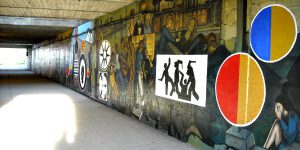
How can time be made visible? “Seeing The Invisible”, the current exhibit at Marwen’s Untitled gallery seeks to answer this question. The show includes series of photographs and video installations by Marta Shumylo, a Marwen alumna and student at the Milwaukee School of Art and Design, along with her professor Sonja Thomsen, whose work can also be found in the permanent collection of the Milwaukee Art Museum.
Marwen’s mission is to educate and inspire under-served middle and high school youth through the visual arts. However, it continues to supports students after they graduate through efforts like Untitled, its alumni gallery. Through Untitled, former students can exhibit their work or curate the work of others. Marta, who attended Marwen during her last two years of high school, saw the exhibit as a way to both show her appreciation and inspire its current students.
“Seeing The Invisible” contains three series of photography. The first is a collaboration between Marta and Sonja entitled “Home/Away” and comprised of fourteen diptychs. To create the pieces, they spent the summer taking photographs simultaneously in two very different locations. Sonja’s were shot at 8 am in the US while Marta’s were taken at 4 pm in Ukraine. When I first saw the photographs, I was unaware of the story behind them. So, thinking they were by a single artist, I assumed that the patterns and narratives I discovered were intentional. After learning that the combinations relied completely on chance, the diptychs became more extraordinary. For instance, through sheer coincidence, both women had photographed plants in front of a lone window on July 6th. Again on July 10th, the photographs contained subtle silhouettes of plants towards the corners of their compositions. It was also hard to resist looking for meanings within the combinations. On July 27th the left photograph contained a half-eaten watermelon and bottle of liquor resting on a ruffled blanket spread out on rocky ground. “Were these the possessions of a homeless person?” I wondered. Meanwhile, the other photo was of a cat lying indoors in a patch of sunlight. Maybe the piece was expressing the cruel irony of a cat enjoying domestic pleasures a homeless person can only hope for. Then again, maybe not. Often I find the guessing game presented by unlabeled contemporary art to be tiresome, but with “Home/Away” it was enjoyable and at times effortless.

The next series was comprised of black and white Polaroid self-portraits of Sonja at different stages of pregnancy. Contrasting sharply were Marta’s crisp, full color photographs of moldy fruit, placed on the opposite wall. Oddly enough, rotting fruit was the original inspiration behind the exhibit. “The beginning of the Rotten Fruit series was when I opened my fridge one day and saw a fruit that was slightly covered by mold. Instead of being disgusted I was amazed by the effect that time had on it,” wrote Marta in a dialogue between her and Sonja (also featured in the exhibit). For the photographs, Marta wrote that she had surprising difficulty getting the fruit to rot the way she wanted. Ultimately the work paid off. The photographs are bold and stunning. Set against a red background, the deteriorating fruits cannot be ignored.
It was only after Sonja and Marta had been collaborating on the exhibit for a few months that Sonja became pregnant. Inspired by her body’s own visual manifestation of time, she decided to document her pregnancy as an antithesis to Marta’s photographs of rotting fruit. While one series represents decay, the other presents the growth of new life. Accompanying the photographs is a video which simultaneously displays Sonja receiving ultrasounds at different stages of pregnancy.
The last instance of time featured in the exhibit is a second television which displays clips of Sonja and Marta printing, choosing, and compiling the photographs that comprised the show. A portion of their year-long process is boiled down to eleven minutes of fast-motion footage. It’s fitting that an exhibit about time would include even its preparation as an example of tempus fugit.
Though the three series in “Seeing The Invisible” depict several very different manifestations of time (time as tied to unique moments, biological decay, and prenatal growth), for me they came together to transmit the same message. Life is constantly moving forwards, and therefore nothing is permanent. The scenes captured in “Home/Away” are moments in time that can never be repeated in precisely the same way. Likewise, the moldy fruit would only continue to decay, and Sonja’s belly would eventually regain its earlier shape, but the life inside would emerge and continue growing. It takes a good exhibit to represent something as universal as time in an intimate, powerful way, and “Seeing The Invisible” has done just that.
“Seeing The Invisible” runs through March 12 at Marwen. Further information concerning the show can be found here.



